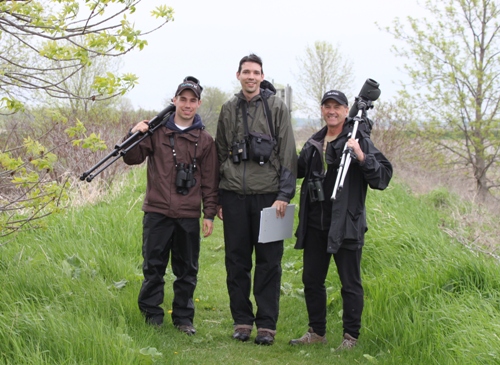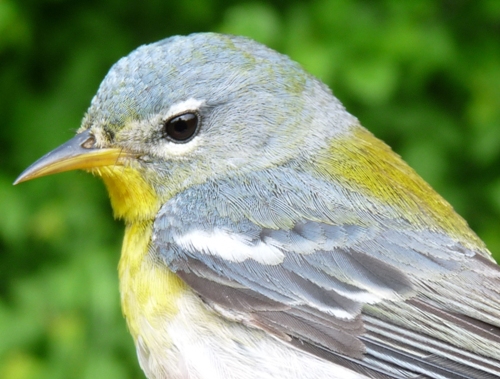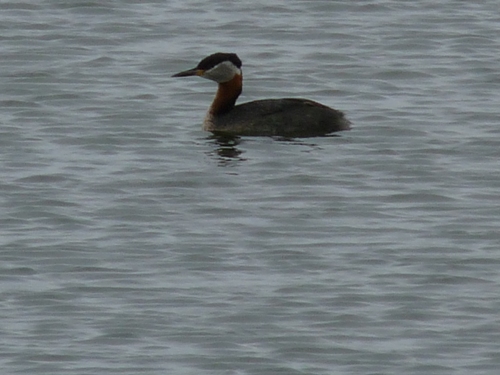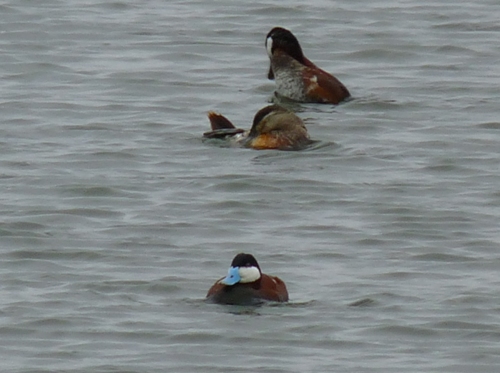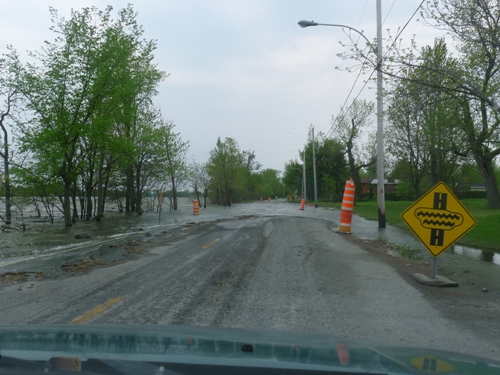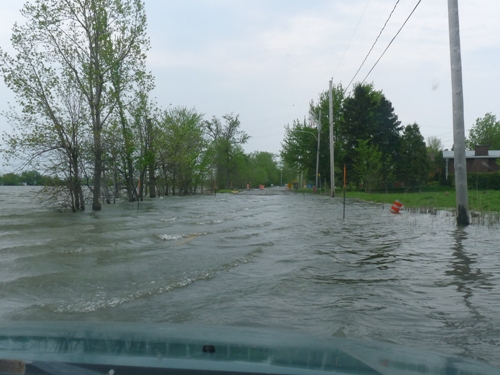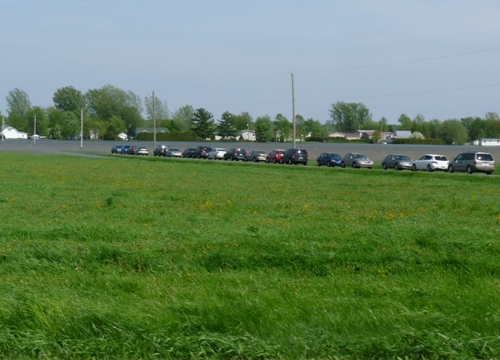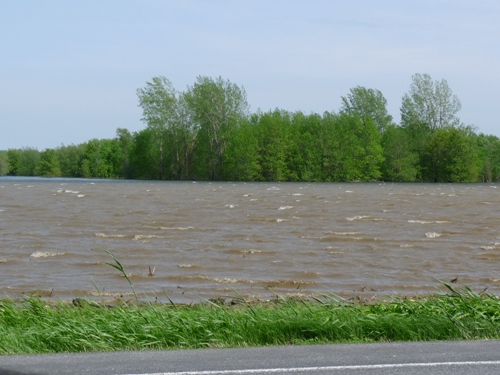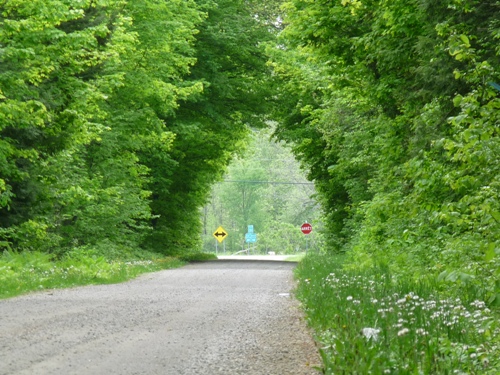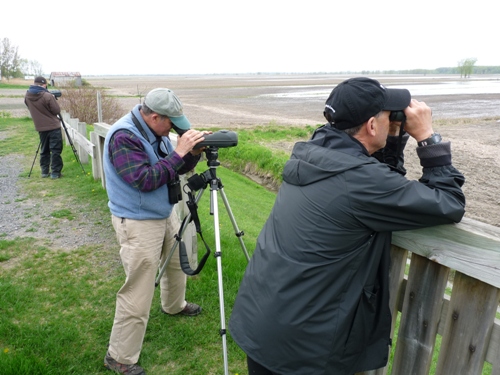|
MIGRATION RESEARCH FOUNDATION |
|||||||||||||||||||||||||||||||||||||||||||||||||||||||||||||||||||||||||||||||||||||||||||||||||||||||||||||||||||||||||||||||||||||||||||||||||||||||||||||||||||||||||||||||||||||||||||||||||||||||||||||||||||||||||||||||||||||||||||||
After a couple of years of doing my Birdathon mostly to entirely on foot, I decided to roam more widely this year. Back in 2005, I did my Birdathon as a part of a group (the “Raven Loonaticks”) hoping to break the single-day record for birds observed in Quebec, which was 166 at the time. We fell slightly short with 160, but had a great time and enjoyed seeing a variety of the province’s great habitats, especially the large forests and wetlands. Since then, another intrepid team has raised the bar to 175. All the same, circumstances conspired this spring that three members of our original team (myself, David Bird, Rodger Titman) and a new recruit (Simon Duval) were all available and eager to do a Birdathon around the same date, and thought we’d give it another try, under the slightly modified name of “Raven Loon-a-tits”, to be all the more birdy.
There has been a record amount of rain in southern Quebec this spring, especially in May, so it wasn’t surprising that rain was in the forecast for the two days we were able to choose between with respect to everyone’s availability. After a fair bit of consideration, we decided to give it a try on the first of the two options, Monday May 23. We met at Rodger’s home around 10 pm for some final (or so we thought at the time) strategy discussions, and then by 11:30 we were on our way to Ile Bizard, so that we could be in place for the count to begin at midnight. Sure enough, as we drove the short distance to the park, the rain became heavier, and so we set out in waterproof gear from head to toe, wondering whether we were perhaps not still closer to lunatics than loon-a-tits! However, marsh birds don’t mind the rain of course, and within our first few minutes we already heard Marsh Wren, Mallard, Canada Goose, and Common Moorhen. Continuing to the forest on the far side, the local pair of Barred Owls then rewarded us with some nice hooting at close range, and on our walk back through the marsh we were able to bring our first-hour total to 11 species with the addition of American Bittern, Virginia Rail, Sora, Swamp Sparrow, Wood Duck, and at the last minute, Pied-billed Grebe. The last time we were out, we made Mont Tremblant our second stop, and although beautiful and teeming with most boreal species, we found that it was a long drive from there to any other productive locations. This time, we gambled by replacing it with Mauricie National Park – a slightly longer drive from Montreal, but much closer to other productive locations, so it minimized time lost to driving during daylight hours. However, Rodger was the only one among us who had ever visited the park before, so we went in with relatively limited knowledge, gleaned mostly from Simon’s conversations with other birders more familiar with the park, and knew that we would have to rely on our knowledge of bird ecology to find the various species we were seeking. We arrived in the dark, having picked up species #12 on the way – a House Sparrow fly-catching around lights at a gas station off Highway 40! The rain kept with us through most of the drive, brief breaks being offset by periodically heavier downpours. We pulled into the Mekinac parking lot around 3:30 am, expecting to take a quick nap before the dawn chorus began, but the birds had other plans for us, and we weren’t about to argue. A White-throated Sparrow started singing soon after we arrived, and before 4 am we realized that we had stumbled on the display grounds of a group of American Woodcock. The combination of the open area of the parking lot and the surrounding “second-growthy” forest made it attractive to them, but all the same we hadn’t expected that, and having the chance to listen to their display and see a couple of them waddling around the parking lot was among the highlights of our day. As dawn approached we were still alternating between drizzle and light rain, and no doubt that subdued bird song somewhat. All the same, the numbers began to climb quickly. At the same parking area, we added Common Loon, Winter Wren, Veery, Swainson’s Thrush, American Robin, Nashville Warbler, and even a Common Goldeneye flying overhead, giving away its identity through its whistling wings. Over the next couple of hours, we made a series of stops along the main park road where habitat looked promising, bringing our count to 47 species by 6 am – a very decent start, considering that the precipitation still hadn’t stopped. During this stretch we added 12 more warbler species, including our only Canada Warbler of the day, a couple of Pine Warblers, and the first several of surprisingly many Northern Parulas.
We went into the Lac Edouard picnic area having heard that Gray Jays frequent it, but struck out ... presumably they were smart enough to know there wouldn’t be many people to mooch food from so early in the day. But we added a Yellow-shafted Flicker drumming on a garbage bin, as well as one of surprisingly few Common Ravens, and our first American Goldfinch. At another spot soon after that we saw a gorgeous flame-throated Blackburnian Warbler. As we progressed west through the park, we added other nice finds such as White-winged Crossbill and Ring-necked Duck, but the rate of new discoveries was tapering off, and initial hopes for reaching 80-100 species within the park were beginning to falter. By the time we got to Ile-aux-Pins, we were debating whether the 250 metre walk down to the lookout would be worthwhile, but fortunately we gave it a try. Looking out over the misty scene below (and speculating how impressive it must be when fully visible), we heard our only Yellow-bellied Flycatcher, Cape May Warbler, and Scarlet Tanager of the day, plus our first Least Flycatcher. As we left the park, we added Belted Kingfisher and Alder Flycatcher, bringing our total to 65 so far. Although that was lower than we had hoped, we were missing many “common” species such as Downy Woodpecker and Cedar Waxwing and figured they would be easy enough to add later in the day ... little did we know how wrong we were about that! Our next stop was under the north end of the Laviolette bridge, crossing the St. Lawrence River at Trois-Rivieres. One of the resident Peregrine Falcons showed itself within minutes, and we also added some “easy” species from the little park by the river, including Great Crested Flycatcher, Yellow Warbler, and Brown-headed Cowbird, having already picked up other blackbirds and ubiquitous birds like European Starling and Rock Pigeon along the drive. As much as anything, we were happy that the rain ended shortly after we left the park, and although it remained overcast, the sky no longer looked threatening. Next we headed to Baie-du-Febvre, a spectacular area of flooded fields and wetlands managed in part by Ducks Unlimited. In just over 90 minutes there, we added 40 species to our list, and the highlights were many. An impressive cloud of Black Terns was in constant motion over the two main ponds – there must have been well over 100 of them, plus others in adjacent wetlands. In those same two cells were lone individuals of two considerable rarities for southern Quebec, a Long-tailed Duck and a Red-necked Grebe. Other uncommon species we saw only there were Northern Shoveler, Redhead, and Ruddy Duck. In the main marsh, we added American Coot, Least Bittern, and Spotted Sandpiper among others, and saw another Peregrine Falcon perched on a tree on the far side. Moving up the road slightly back toward the river, we came across some mudflats with a great assortment of shorebirds that included American Golden Plover and Black-bellied Plover side by side, as well as Least, Semipalmated, and White-rumped Sandpipers grouped for easy comparison, plus Dunlin, Ruddy Turnstone, and Semipalmated Plover. Other highlights at Baie-du-Febvre included Black-crowned Night Heron, 4 Bald Eagles, and a good number of Snow Geese, some of which were remarkably tame.
As we headed southwest toward Chambly, we added a few other species along the way, ranging from Osprey and Turkey Vulture to Bank Swallow. But we also noticed the wind was picking up considerably, and wondered how that would now interfere with our ability to detect birds. However, our next stop was at Fort Chambly, and we figured the swallows and waterbirds that were our main targets there wouldn’t be too much harder to see under such conditions. What we hadn’t bargained on though was the highway being flooded! Lake Champlain reached record levels earlier this month, and in turn the flooding along the Richelieu River has been worse than ever, but we hadn’t realized water levels remained this high, especially so far north. After carefully fording one stretch where the river was spilling over the road, we detoured out to the west and made a wide loop to come back into Chambly. As it turned out, the choppy conditions did make it difficult to spot birds swimming on Chambly basin, but we did at least add Bonaparte’s Gull and Northern Rough-winged Swallow to bring our count to 123 species.
We had been planning to follow the east side of the river to the Maurice-Raymond Ecological Reserve, but figured that given the water level, that site might also be flooded, and didn’t want to gamble with road conditions on the far side of the river. So, we instead headed down along the west side of the Richelieu, and along the way gained an appreciation for the extent of the flooding. One sideroad after another had extensive flooding, with cars parked all along it, belonging to the people whose houses along the river were still partly underwater. There must be many hundreds if not thousands of people along that stretch who remain flooded out of their homes – it has already been a few weeks, and it will surely take a few more for the water to subside to within the river’s banks, especially if it keeps raining as it has been. The flooded areas were deep enough, and the wing strong enough (probably 40-50 km/h) that there were even whitecaps on these temporary lakes. We added a few species along this stretch including American Wigeon and Green Heron, and thanks to Dave looking closer to the road while the rest of us were scanning a flooded area, we also got Northern Cardinal at last. However, it was the power of the river that left the greatest impression on us all.
By the time we left the Richelieu Valley, it was 3:30 pm. Having saved some time by deciding to omit the Maurice-Raymond reserve, we decided we’d explore the back roads of southwestern Quebec a bit more extensively than we had originally planned. We went south of Hemmingford, drove through Covey Hill, and over to the Pitch Pine Ecological Reserve, and saw a variety of nice habitats along the way. Unfortunately, we couldn’t shake the wind, and combined with the usual afternoon lull in bird song, there were many places where we anticipated new species might be found, but came away empty-handed. This was all the more surprising given that our list of species was still missing many common forest and edge birds that should be easy to encounter in suitable habitat. We gradually nibbled away at a few of these (e.g. House Wren, Rose-breasted Grosbeak, Baltimore Oriole), but we were amazed at how long it had taken us to find them, and how many others remained elusive. By around 6 pm, we had reached Gowan Road, which goes through a beautiful stretch of mostly mature hardwood forest, and is renowned for being one of the best birding spots in the Montreal region, especially for regional rarities like Yellow-throated Vireo and Golden-winged Warbler. Unfortunately our luck there wasn’t much better – we added Eastern Wood-Pewee at last to bring us to 134, but we all agreed it would be nice to see/hear this location bursting with activity, as it probably would be most mornings. Not for the first time, we lamented that it’s unfortunate we can’t get to more of the “best” spots for songbirds during the critically active early morning period, but it’s always a matter of having to pick one or two locations at the expense of all others.
One of the other famous roads in the area is Montee Biggar, with a largely natural shrubby and successional habitat along with some patches of mature hardwood forest. Unfortunately it had been years since I last visited the area, so I relied on Google Maps to guide me ... and thanks to there being two parallel roads called “Chemin Ridge” within about 10 km of each other, we ended up taking an unnecessary detour through Athelstan. It wasn’t all for nought though, since the corrective route took us past a trio of Chimney Swifts, which Rodger’s sharp ears picked up through the open window as we drove past. When we finally found Montee Biggar, we got a fresh set of species rather quickly, in the form of Wilson’s Snipe, Grasshopper Sparrow, and then a bit further down the road, Golden-winged Warbler. We knew that again we were missing other regulars there such as Eastern Towhee and Field Sparrow, but we were happy to find the species that we did. We had less than an hour remaining until sunset, and decided our best bet would be to squeeze in a visit to Dundee Marsh, in the extreme southwest corner of the province, on the southern edge of Lac St-Francois. On our way there, we finally saw a Red-tailed Hawk; raptors had been incredibly difficult to come by all day long, so it was quite a relief to finally get the most common of them on our list. Walking along the dyke at Dundee, a Hairy Woodpecker in the alders became species #140. We then enjoyed a nice look at a pair of nesting Sandhill Cranes (very rare in southern Quebec), obligingly right across from an observation blind, and just at dusk had a Gray Catbird begin to sing, capping our list at 142 species. Given that we were well short of our record, and the day was ending as it began with the return of rain as we reached the car, we decided to head home rather than try for one or two more owls in the dark. Our 142 species included 15 waterfowl, 10 herons/cranes/rails, 8 raptors, 3 woodpeckers, 7 flycatchers, all 6 Quebec swallow species, 21 warblers, and 8 sparrows. Among those in the “we-can’t-believe-we-missed-these” category were Green-winged Teal, Great Horned Owl, Downy Woodpecker, Pileated Woodpecker, White-breasted Nuthatch, Cedar Waxwing, Brown Thrasher, and Indigo Bunting, with dishonourable mention going to Bufflehead, Broad-winged Hawk, Sharp-shinned Hawk, Merlin, Solitary Sandpiper, Common Nighthawk, Eastern Whip-poor-will, Ruby-throated Hummingbird, Willow Flycatcher, Horned Lark, Brown Creeper, Mourning Warbler, Eastern Towhee, Field Sparrow, and Vesper Sparrow. All of those species are either outright common, or regular enough breeders at one or more of the locations we visited that we should have had a good chance of seeing them under good conditions, but the weather hurt our chances through most of the day. Had we recorded all of these, we would have reached 165 species – and under better conditions it might well be possible to find an extra 10 species beyond that from among the many others regularly present in the region at this time of year (though less reliable to find), such as Greater and Lesser Scaup, Red-breasted Merganser, Great Egret, Cooper’s Hawk, Northern Goshawk, Red-shouldered Hawk, Lesser Yellowlegs, Upland Sandpiper, Caspian Tern, Yellow-billed and Black-billed Cuckoo, Eastern Screech-Owl, Northern Saw-whet Owl, Red-bellied Woodpecker, Olive-sided Flycatcher, Yellow-throated Vireo, Gray Jay, Tufted Titmouse, Blue-winged Warbler, Wilson’s Warbler, Clay-colored Sparrow, Lincoln’s Sparrow, and Rusty Blackbird.
Regardless of the fact we fell short of our goal, we all had a great time, coming away with lasting memories such as our pre-dawn woodcock entertainment, hearing the Barred Owl pair call to each other in the middle of the night, the massive swarm of Black Terns at Baie-du-Febvre, and the mixed chorus of boreal song drifting up to us out of the mist at the Ile aux Pins lookout. Additionally, we all discovered places we’ve never been before, and might have otherwise not made the effort to explore, but now realize are worth another visit. Perhaps the Raven Loon-a-tits will reunite at some point to try our luck again with this route (or another), but in any case we had a lot of fun trying this time, and very much appreciate all of you who sponsored our Birdathon in support of research at McGill Bird Observatory. If you've already contributed to my Birdathon this year, thank you so much for your support! As usual, we're counting on Birdathon proceeds to be a critical part of funding the continued operation of migration monitoring programs at McGill Bird Observatory, where we are now in our seventh full year of operation and trying to maintain consistent coverage from year to year so that we can detect population trends over time. In case you didn't make a pledge in advance of my count, but would still like to support this year's Birdathon, it's not too late to make a flat-rate donation online. Thank you all!
Quebec Birdathon, May 23, 2011 --- List of 142 bird species seen and/or heard
|

